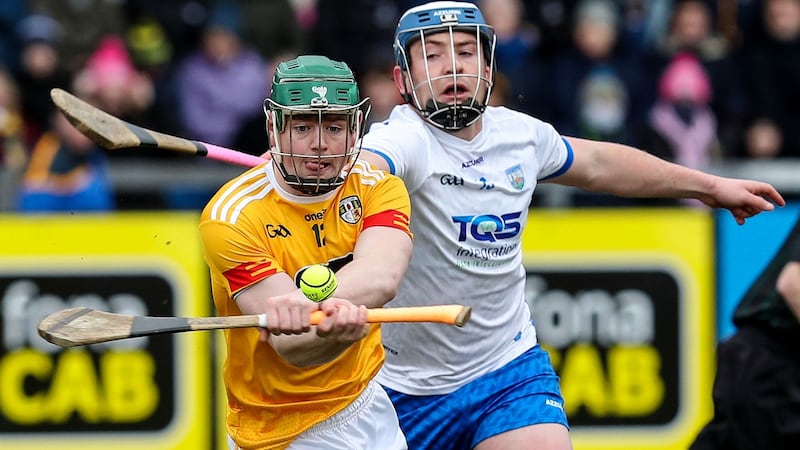Cork hurlers and management in their public utterances have been careful to project a respectful view of Corrigan Park as “a hostile environment” for visiting teams.
There is a contemporary resonance to this in Antrim’s competitiveness since returning to Division One of the Allianz Hurling League last year. They were unbeaten at their Belfast home, including wins over Clare and Laois and a draw with Wexford.
The competitive form was maintained this season, albeit reflected in narrow defeats against Dublin and Waterford rather than another unbeaten run. This weekend will see a homecoming for the second McDonagh Cup win in three years and with it the right to entre a preliminary All-Ireland quarter-final. But that’s not a complete summary of the venue’s story.
Mention of Corrigan Park in an historical context also raises caveats. Saturday’s preliminary quarter-final is the first senior championship hurling match at the venue since the 1940s. From the 1950s on, Casement Park became the Antrim county ground.
If hurling is so good, why is it so small?
Meath scored more in one half against Dublin than entirety of previous nine meetings
Ricardo De Burgos Bengoetxea’s crazy minute shows how hard it is to referee El Clásico
Fin Smith meets Sam Prendergast in latest test of young outhalves under constant scrutiny
In recent times when the county had home fixtures in the Leinster preliminary group, they were hosted in Ballycastle.
In 1943, Antrim hurlers had one of their two standout All-Ireland campaigns. Galway came to Corrigan Park and were beaten, on a scoreline of its time 7-0 to 6-2, followed by Leinster champions Kilkenny on August 1st.
In Seamus King’s History of Hurling, he outlines the scale of the surprise.
“Antrim’s success over Galway was regarded as a fluke and Kilkenny were expected to achieve victory. When the result of the game, 3-3 to 1-6, came over the radio on Sunday night it created a sensation and qualified the Northerners for their first All-Ireland. They had led at half-time by 2-2 to 1-3 and their defence never wilted despite frenzied attempts by the Noresiders to get the equalising goal.
“Kilkenny’s followers found the defeat hard to take and when the team returned home on Monday evening – having left on the first stage of the journey on Friday evening – they were accused of being drunk during the game.”

This is a recurrent analysis of unexpected defeats. When Kerry were equally sensationally defeated by Antrim in the 1912 All-Ireland football semi-final, a story emerged that players had the night before attended a lavish party hosted by wealthy Kerry man.
Corrigan Park, named after John Corrigan a prominent GAA official in the county during the early years of the 20th century, was the Antrim county ground until the decision was taken to develop Casement.
The question arose what to do with Corrigan Park. There were suggestions that it could be sold to defray the cost of the new ground. Instead the St John’s club, founded in 1929 and with its base on the Springfield Road, stepped in – a dauntingly bold initiative at the time.
According to PRO Jim Donnelly, “clubs didn’t by and large have their own grounds in the 1950s”. The attention paid to Casement meant that the club would have to raise the funds itself.
Maria Gough wrote Come and See the Johnnies Play, a history of the club, which was exhaustively researched by her brother-in-law John Gough, the well-known intercounty football referee whose work was cut out for him after a fire in the club destroyed some valuable archive and he had to source material elsewhere.
“The club was kick-started by a sermon given by Fr Bob Fullerton at the opening of St John’s parish church and a number of men in the parish were moved to establish the club. It’s very family orientated and to this day, children of members come back to play.”
Although a dual club, it probably has a higher profile in football, having won an Ulster club title and then reached the 1978 All-Ireland final. Antrim’s only football All-Star to date, Andy McCallin, who was honoured in the scheme’s inaugural year, 1971.
Corrigan Park moved back into the spotlight in recent years because of all the delays to attempts to redevelop Casement Park, which is still awaiting the commencement of its rebuilding project, having been closed for most of the past decade,
With the stadium closed, Corrigan Park has resumed its old function as the county ground despite a small capacity of around 4,000. There have been a couple of football championship matches played there – most recently the Ulster championship fixture against Cavan, which was briefly controversial when the latter tried – unavailingly – to have the venue switched.
The Casement deadlock looks finally to have been broken and in the years ahead, St John’s ground can revert to a less hectic schedule.
“It’s good that it looks like Casement will be developed,” says Maria Gough, “but it’s been nice for us to be able to welcome teams from all over Ireland to our ground.”
Cork are the latest and they will, as they have been observing this week, find a great welcome until they take to the pitch.














